Hsinbyushin was king of the Konbaung dynasty of Burma (Myanmar) from 1763 to 1776. The second son of the dynasty founder Alaungpaya is best known for his wars with Qing China and Siam, and is considered the most militaristic king of the dynasty. His successful defense against four Qing invasions preserved Burmese independence. His 1765 invasion of Ayutthaya brought an end to the Ayutthaya Kingdom. The near simultaneous victories over Qing and Siam has been referred to as testimony "to a truly astonishing elan unmatched since Bayinnaung." He also raised the Shwedagon Pagoda to its current height in April 1775.
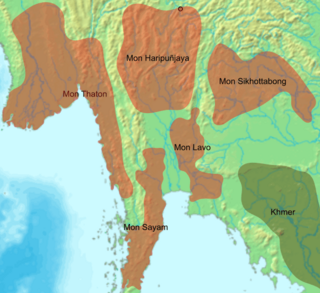
Mon kingdoms were polities established by the Mon-speaking people in parts of present-day Myanmar and Thailand. The polities ranged from Dvaravati and Haripuñjaya in present-day northern Thailand to Thaton, Hanthawaddy (1287–1539), and the Restored Hanthawaddy (1740–1757) in southern Myanmar.

Tanintharyi Region is a region of Myanmar, covering the long narrow southern part of the country on the northern Malay Peninsula, reaching to the Kra Isthmus. It borders the Andaman Sea to the west and the Tenasserim Hills, beyond which lie Thailand, to the east. To the north is the Mon State. There are many islands off the coast, the large Mergui Archipelago in the southern and central coastal areas and the smaller Moscos Islands off the northern shores. The capital of the division is Dawei (Tavoy). Other important cities include Myeik (Mergui) and Kawthaung. The division covers an area of 43,344.9 square kilometres (16,735.6 sq mi), and had a population of 1,406,434 at the 2014 Census.
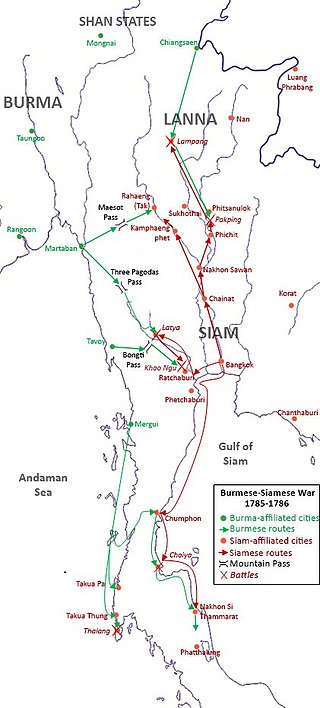
The Burmese–Siamese War (1785–1786), known as the Nine Armies' Wars in Siamese history because the Burmese came in nine armies, was the first war between the Konbaung dynasty of Burma and the Siamese Rattanakosin Kingdom of the Chakri dynasty.

The Tha Din Daeng campaign was a short conflict, occurring in 1786 in Tha Din Daeng, now in Kanchanaburi Province in western Thailand. The belligerents were King Bodawpaya of the Burmese Konbaung Dynasty, against Phraphutthayotfa Chulalok and Maha Sura Singhanat of the Rattanakosin Kingdom.
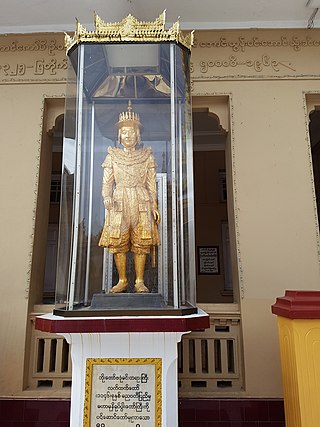
Thado Minsaw, also known as Shwedaung Min (ရွှေတောင်မင်း), was heir-apparent of Burma from 1783 to 1808, during the reign of his father King Bodawpaya of Konbaung dynasty. As Prince of Shwedaung and Dabayin, he was entrusted by the king to manage the day-to-day affairs of the kingdom, and when necessary, to lead the Royal Army against enemies. Thado Minsaw is best known for his conquest of Arakan in 1784–1785 and the subsequent removal of Mahamuni Buddha from Mrauk-U to Amarapura. He also led the successful defense of Tenasserim (Taninthayi) coast in 1792 in the war with Siam. The crown prince also led the revitalization of Burmese theater in the late 18th century by bringing a group of young artists to his court.

The Burmese–Siamese War (1547–1549), also known as the Shwehti war was the first war fought between the Toungoo dynasty of Burma and the Ayutthaya Kingdom of Siam, and the first of the Burmese–Siamese wars that would continue until the middle of the 19th century. The war is notable for the introduction of early modern warfare to the region. It is also notable in Thai history for the death in battle of Siamese Queen Suriyothai on her war elephant; the conflict is often referred to in Thailand as the War that Led to the Loss of Queen Suriyothai (สงครามคราวเสียสมเด็จพระสุริโยไท).

The Restored Hanthawaddy Kingdom, also known as the Neo-Ramanic State was the kingdom that ruled Lower Burma and parts of Upper Burma from 1740 to 1757. The kingdom grew out of a rebellion by the Mon led population of Pegu, who then rallied the other Mon as well as Delta Bama and Karens of Lower Burma, against the Toungoo Dynasty of Ava in Upper Burma. The rebellion succeeded in expelling Toungoo loyalists and restored the Mon-speaking Kingdom of Hanthawaddy which ruled Lower Burma from 1287 to 1539. The restored Hanthawady kingdom also claim heritage to Bayinaung's early Toungoo Empire whose capital was based in Pegu and guaranteed the loyalty of the non-Mon population of Lower Burma. Supported by the French, the upstart kingdom quickly carved out a space for itself in Lower Burma, and continued its push northward. In March 1752, its forces captured Ava, and ended the 266-year-old Toungoo dynasty.
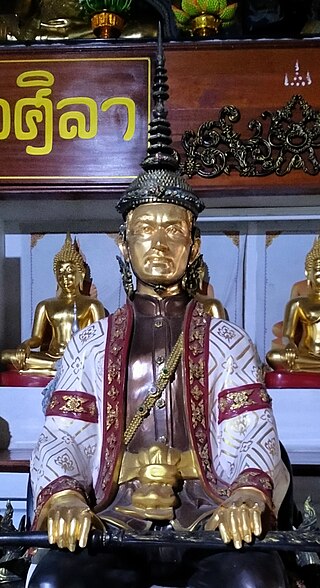
Ekkathat or Borommoracha III or King of Suriyamarin Throne Hall was the 6th monarch of the Ban Phlu Luang dynasty, the 33rd and the last monarch of Ayutthaya Kingdom, ruling from 1758 to 7 April 1767, prior to the fall of Ayutthaya. Moreover, he was called by the people in his time as "King Khiruean", which meant "the king with skin disease", due to his chloasma.

The Konbaung–Hanthawaddy War was the war fought between the Konbaung Dynasty and the Restored Hanthawaddy Kingdom of Burma (Myanmar) from 1752 to 1757. The war was the last of several wars between the Burmese-speaking north and the Mon-speaking south that ended the Mon people's centuries-long dominance of the south.

The Burmese–Siamese War (1759–1760) or Alaungpaya's War was the military conflict between the Konbaung dynasty of Burma (Myanmar) and the Ban Phlu Luang Dynasty of the Ayutthaya Kingdom of Siam, in which the Burmese forces under King Alaungpaya of the Konbaung dynasty invaded Siam. After about a century of relative hiatus of Burmese–Siamese conflicts, this war reignited the new round of military conflicts between Burma and Siam that would last for about a century to come.
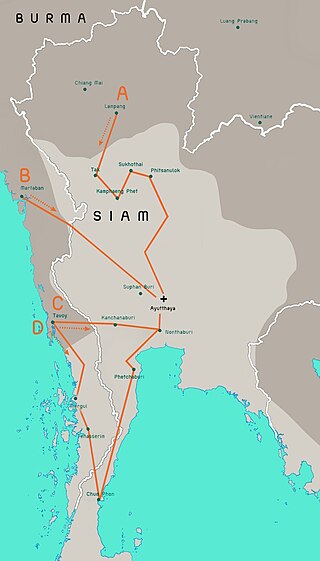
The Burmese–Siamese War of 1765–1767, also known as the war of the second fall of Ayutthaya was the second military conflict between Burma under the Konbaung dynasty and Ayutthaya Kingdom under the Siamese Ban Phlu Luang dynasty that lasted from 1765 until 1767, and the war that ended the 417-year-old Ayutthaya Kingdom.
The military history of Myanmar (Burma) spans over a millennium, and is one of the main factors that have shaped the history of the country, and to a certain degree, the history of Southeast Asia. At various times in history, successive Burmese kingdoms were also involved in warfare against their neighbouring states in the surrounding regions of modern Burmese borders—from Bengal, Manipur and Assam in the west, to Yunnan (the southern China) in the northeast, to Laos and Siam in the east and southeast.

The Burmese–Siamese War (1593–1600), also known as the Naresuan War (ဗြနရာဇ်စစ်ပွဲ)was the war fought between the Toungoo Dynasty of Burma and the Ayutthaya Kingdom of Siam. The war was the culmination of Siam's move towards independence following subjugation after the Burmese–Siamese War (1584–1593). The war ended with a victory by Siam, which seized the cities of Tavoy and Tenasserim, and laid siege to two major cities of the Toungoo Dynasty.
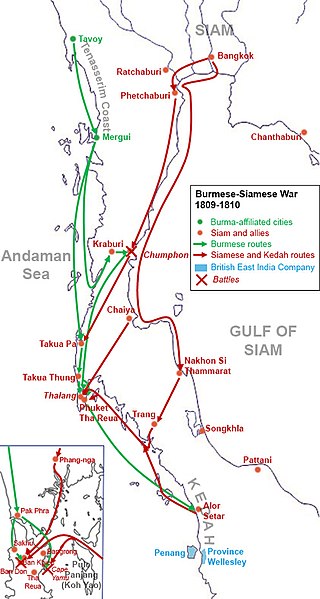
The Burmese–Siamese War (1809–1812) or the Burmese Invasion of Thalang was an armed conflict fought between Burma under Konbaung dynasty and Siam under the Chakri dynasty, during the period of June 1809 and January 1812. The war centered on the control of the Phuket Island, also known as Thalang or Junk Ceylon, and the tin rich Andaman Coast. The war also involved the Kedah Sultanate. This occasion was the last Burmese offensive expedition into Siamese territories in Thai history, with British acquisition of the Tenasserim Coast in 1826, following the First Anglo-Burmese War, removing several hundred miles of the existing land border between Siam and Burma. The war also left Phuket devastated and depopulated for many decades until its reemergence as a tin mining center in the late 19th century.

The Burmese–Siamese War (1775–1776) or Maha Thiha Thura's Invasion of Siam or Athi Wungyi's War was a major military conflict between the Konbaung dynasty of Burma and the Thonburi Kingdom of Siam.
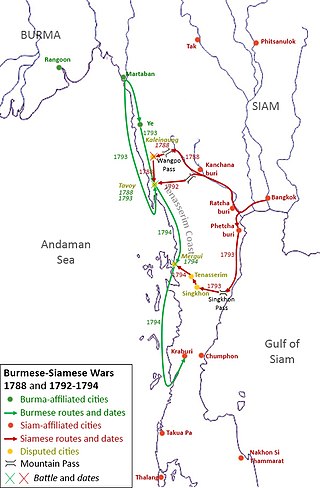
The Burmese–Siamese War (1792–1794) or the Siamese Invasion of Tavoy was the conflict between the Kingdom of Burma under Konbaung dynasty and the Kingdom of Siam under the Chakri dynasty over the town of Tavoy and the Tenasserim Coast.

The Burmese–Siamese War (1802–1805) was the military conflict between the Kingdom of Burma under the Konbaung dynasty and the Kingdom of Siam under the Chakri dynasty over the Lan Na city-states. It is composed of two parts: the Burmese Invasion of Chiang Mai in 1802 and the Siamese Invasion of Chiang Saen in 1804.

The Burmese-Siamese War (1797–1798) was a military conflict between the Kingdom of Burma under the Konbaung dynasty and the Kingdom of Siam under the Chakri dynasty over the Lan Na city-states.
Chaophraya Mahasena, personal name Pli, was the Samuha Kalahom or Prime Minister of Southern Siam from 1782 to 1794. He was known for his roles in many military campaigns for Siam in the late eighteenth century.


















